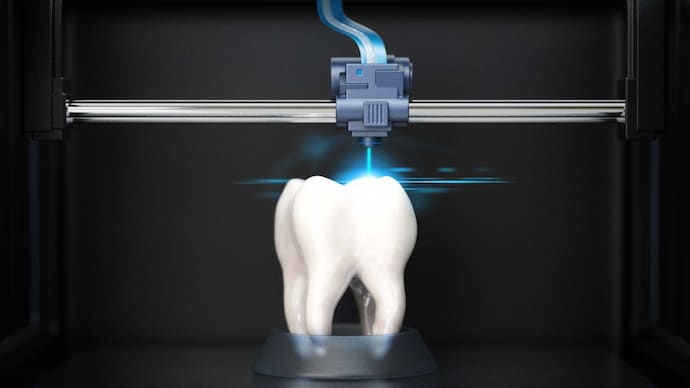3D-printing your teeth: How an Indian breakthrough has changed dentistry
Indian scientists have introduced a sustainable 3D printing technology called Photoinduced Radical Polymerization (PRP) into dentistry, which eliminates the need for solvents and heat.

Indian scientists have developed a new technology in 3D printing and dental restoration that is a step forward in dentistry.
This light-activated chemical process, known as photoinduced radical polymerization (PRP), is a sustainable and cost-effective option that holds great promise in 3D printing and dental fillings.
The photoinduced radical polymerization (PRP) process is a new method combining two advanced technologies to create stronger, longer-lasting materials.
It works by using light to trigger a reaction that links molecules together, forming a solid without the need for any heat. This process relies on a special component called a “photoinitiator”, which starts the reaction when it absorbs light.
Excluding the need for heat, this technology is safer, more efficient, and environmentally friendly, making it useful in dentistry, 3D printing, and other fields.
The research, led by Dr. Ajoy Kapat, Assistant Professor, School of Natural Sciences, Shiv Nadar University, focuses on a new “co-initiator” that improves the efficiency of PRP, making it an eco-friendly alternative with versatile applications. It becomes.
PRP is gaining popularity due to its simplicity, low energy requirements, and environmentally friendly approach.
Unlike traditional methods, PRP does not require solvents or heat, making it a safe and sustainable option for modern applications.
This process, initiated by light, helps create materials made of polymers or long chains of molecules, which is important in areas such as dental restoration and high-precision 3D printing.
Dr. Kapat and his team designed a new co-initiator that aids the PrP reaction. “Photoinduced radical polymerization combines polymerization tools and photocatalytic techniques,” Dr. Kapat said.
“It is a highly efficient process, activated by light and does not require heating. Additionally, it is a solvent-free process, making it a green option.”
How has it changed the dental industry?
Over the past decades, various organic photoinitiators have been developed for such reactions, but they often come with limitations such as high catalyst loading and toxic by-product formation.
The team’s new co-initiator, together with Kapoor Quinones, addresses these issues, showing excellent response under light conditions and in the presence of oxygen.
This innovation is already finding application in the dental industry, where the need for durable, aesthetically pleasing materials is critical.
Traditional dental fillings often face issues such as volumetric shrinkage and discoloration due to the presence of toxic by-products.
According to Dr. Kapat, light-curing composite materials, which rely on PRP, are becoming increasingly popular in modern dentistry because of their quick polymerization time that takes only 20 to 40 seconds.
Older methods of filling teeth often used chemicals called aromatic amines, which can produce toxic byproducts and discolor teeth over time.
The new system developed by the team avoids these chemicals, using only small amounts (0.1%) of safe ingredients to create strong, deep fillings up to 3 cm thick. This method has also been demonstrated to maintain its color stability for more than two years.
Dr. Kapat believes this advancement will be attractive to dentists, providing a safer and more reliable solution for filling large quantities of dental cavities.
Beyond dentistry, the PRP procedure holds potential for a variety of industries. “The process can be used in the manufacturing of adhesives, photolithography, microelectronics and solvent-free paints as well as coating furniture and vehicles,” Dr Kapat said.
With applications ranging from tooth restoration to flexible electronics, this research opens the door to a sustainable future in polymer-based manufacturing.